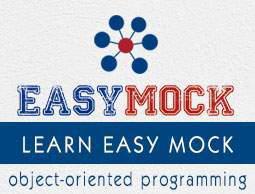EasyMock - Adding Behavior
EasyMock adds a functionality to a mock object using the methods expect() and expectLassCall(). Take a look at the following code snippet.
//add the behavior of calc service to add two numbers
EasyMock.expect(calcService.add(10.0,20.0)).andReturn(30.00);
Here we've instructed EasyMock to give a behavior of adding 10 and 20 to the add method of calcService and as a result, to return the value of 30.00.
At this point of time, Mock simply recorded the behavior but it is not working as a mock object. After calling replay, it works as expected.
//add the behavior of calc service to add two numbers
EasyMock.expect(calcService.add(10.0,20.0)).andReturn(30.00);
//activate the mock
//EasyMock.replay(calcService);
Example without EasyMock.Replay()
Step 1: Create an interface called CalculatorService to provide mathematical functions
File: CalculatorService.java
public interface CalculatorService {
public double add(double input1, double input2);
public double subtract(double input1, double input2);
public double multiply(double input1, double input2);
public double divide(double input1, double input2);
}
Step 2: Create a JAVA class to represent MathApplication
File: MathApplication.java
public class MathApplication {
private CalculatorService calcService;
public void setCalculatorService(CalculatorService calcService){
this.calcService = calcService;
}
public double add(double input1, double input2){
return calcService.add(input1, input2);
}
public double subtract(double input1, double input2){
return calcService.subtract(input1, input2);
}
public double multiply(double input1, double input2){
return calcService.multiply(input1, input2);
}
public double divide(double input1, double input2){
return calcService.divide(input1, input2);
}
}
Step 3: Test the MathApplication class
Let's test the MathApplication class, by injecting in it a mock of calculatorService. Mock will be created by EasyMock.
File: MathApplicationTester.java
import org.easymock.EasyMock;
import org.easymock.EasyMockRunner;
import org.easymock.Mock;
import org.easymock.TestSubject;
import org.junit.Assert;
import org.junit.Before;
import org.junit.Test;
import org.junit.runner.RunWith;
//@RunWith attaches a runner with the test class to initialize the test data
@RunWith(EasyMockRunner.class)
public class MathApplicationTester {
// @TestSubject annotation is used to identify the class which is going to use the mock object
@TestSubject
MathApplication mathApplication = new MathApplication();
//@Mock annotation is used to create the mock object to be injected
@Mock
CalculatorService calcService;
@Test
public void testAdd(){
//add the behavior of calc service to add two numbers
EasyMock.expect(calcService.add(10.0,20.0)).andReturn(30.00);
//activate the mock
//EasyMock.replay(calcService);
//test the add functionality
Assert.assertEquals(mathApplication.add(10.0, 20.0),30.0,0);
}
}
Step 4: Execute test cases
Create a java class file named TestRunner in C:\>EasyMock_WORKSPACE to execute the test case(s).
File: TestRunner.java
import org.junit.runner.JUnitCore;
import org.junit.runner.Result;
import org.junit.runner.notification.Failure;
public class TestRunner {
public static void main(String[] args) {
Result result = JUnitCore.runClasses(MathApplicationTester.class);
for (Failure failure : result.getFailures()) {
System.out.println(failure.toString());
}
System.out.println(result.wasSuccessful());
}
}
Step 5: Verify the Result
Compile the classes using javac compiler as follows:
C:\EasyMock_WORKSPACE>javac Calculator Service.java Math Application.java Math Application Tester.java Test Runner.java
Now run the Test Runner to see the result:
C:\EasyMock_WORKSPACE>java TestRunner
Verify the output.
testAdd(MathApplicationTester): expected:<0.0> but was:<30.0>
false
Example with EasyMock.Replay()
Step 1: Create an interface called CalculatorService to provide mathematical functions.
File: CalculatorService.java
public interface CalculatorService {
public double add(double input1, double input2);
public double subtract(double input1, double input2);
public double multiply(double input1, double input2);
public double divide(double input1, double input2);
}
Step 2: Create a JAVA class to represent MathApplication.
File: MathApplication.java
public class MathApplication {
private CalculatorService calcService;
public void setCalculatorService(CalculatorService calcService){
this.calcService = calcService;
}
public double add(double input1, double input2){
return calcService.add(input1, input2);
}
public double subtract(double input1, double input2){
return calcService.subtract(input1, input2);
}
public double multiply(double input1, double input2){
return calcService.multiply(input1, input2);
}
public double divide(double input1, double input2){
return calcService.divide(input1, input2);
}
}
Step 3: Test the MathApplication class
Let's test the MathApplication class, by injecting in it a mock of calculatorService. Mock will be created by EasyMock.
File: MathApplicationTester.java
import org.easymock.EasyMock;
import org.easymock.EasyMockRunner;
import org.easymock.Mock;
import org.easymock.TestSubject;
import org.junit.Assert;
import org.junit.Before;
import org.junit.Test;
import org.junit.runner.RunWith;
// @RunWith attaches a runner with the test class to initialize the test data
@RunWith(EasyMockRunner.class)
public class MathApplicationTester {
// @TestSubject annotation is used to identify class which is going to use the mock object
@TestSubject
MathApplication mathApplication = new MathApplication();
// @Mock annotation is used to create the mock object to be injected
@Mock
CalculatorService calcService;
@Test
public void testAdd(){
// add the behavior of calc service to add two numbers
EasyMock.expect(calcService.add(10.0,20.0)).andReturn(30.00);
//activate the mock
EasyMock.replay(calcService);
// test the add functionality
Assert.assertEquals(mathApplication.add(10.0, 20.0),30.0,0);
}
}
Step 4: Execute test cases
Create a java class file named TestRunner in C:\>EasyMock_WORKSPACE to execute Test case(s).
File: TestRunner.java
import org.junit.runner.JUnitCore;
import org.junit.runner.Result;
import org.junit.runner.notification.Failure;
public class TestRunner {
public static void main(String[] args) {
Result result = JUnitCore.runClasses(MathApplicationTester.class);
for (Failure failure : result.getFailures()) {
System.out.println(failure.toString());
}
System.out.println(result.wasSuccessful());
}
}
Step 5: Verify the Result
Compile the classes using javac compiler as follows:
C:\EasyMock_WORKSPACE>javac Calculator Service.java Math Application.java Math Application Tester.java Test Runner.java
Now run the Test Runner to see the result.
C:\EasyMock_WORKSPACE>java TestRunner
Verify the output.
true


